NCERT Solutions for Class 7 Maths - Symmetry- 1
Exercise 12.1
Q1: Copy the figures with punched holes and find the axes of symmetry for the following:

Ans:
The axis or line of symmetry is an imaginary line that runs through the centre of a shape creating two perfectly identical halves.

Q2: Given the line(s) of symmetry, find the other hole(s):
 Ans:
Ans:

Q.3. In the following figures, the mirror line (i.e., the line of symmetry) is given as a dotted line. Complete each figure performing reflection in the dotted (mirror) line. (You might perhaps place a mirror along the dotted line and look into the mirror for the image). Are you able to recall the name of the figure you complete?

Ans:
(i) The idea of line of symmetry is linked to mirror reflection. A shape has line symmetry when one half is the mirror image of the other half. A mirror line helps to understand a line of symmetry.
(ii) When working with mirror reflection, it is important to pay attention to the changes in left-right orientation.

Q.4. The following figures have more than one line of symmetry. Such figures are said to have multiple lines of symmetry:

Identify multiple lines of symmetry, if any, in each of the following figures:

Ans:
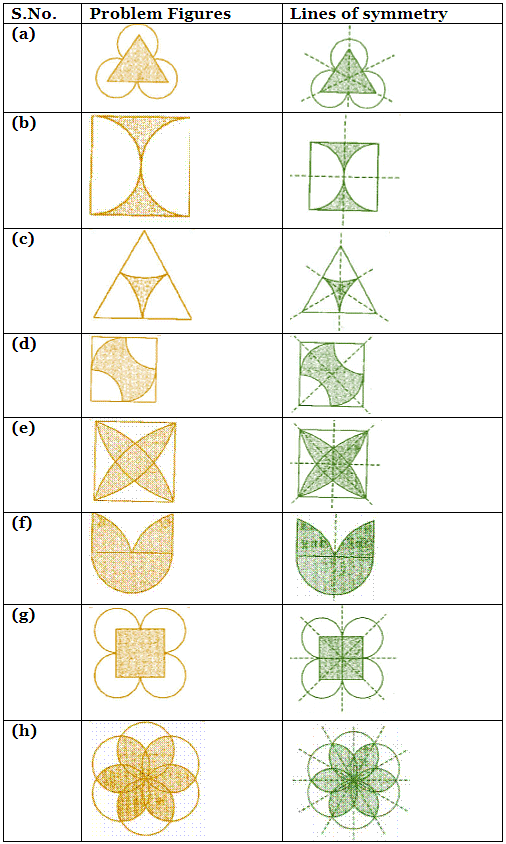
Q. 5. Copy the figure given here:
Take any one diagonal as a line of symmetry and shade a few more squares to make the figure symmetric about a diagonal. Is there more than one way to do that? Will the figure be symmetric about both the diagonals?
Ans: 
Yes, there is more than one way. Yes, this figure will be symmetric about both the diagonals.
Q. 6. Copy the diagram and complete each shape to be symmetric about the mirror line(s):
 Ans:
Ans:
(a) To complete the figure, we need to join the squares exactly the same way as the shape is in on the other side of the line of symmetry. Hence, the completed figure is shown as follows: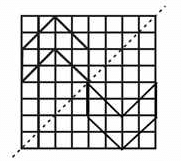
(b) To complete the figure, we need to join the squares exactly the same way as the shape is in on the other side of the line of symmetry. Hence, the completed figure is shown as follows:
(c) To complete the figure, we need to join the squares exactly the same way as the shape is in on the other side of the line of symmetry. Hence, the completed figure is shown as follows:
(d) To complete the figure, we need to join the dots exactly the same way as the shape is in on the other side of the line of symmetry. Hence, the completed figure is shown as follows:
Q.7. State the number of lines of symmetry for the following figures:
(a) An equilateral triangle
(b) An isosceles triangle
(c) A scalene triangle
(d) A square
(e) A rectangle
(f) A rhombus
(g) A parallelogram
(h) A quadrilateral
(i) A regular hexagon
(j) A circle
Ans:

Q.8. What letters of the English alphabet have reflectional symmetry (i.e., symmetry related to mirror reflection) about.
(a) a vertical mirror
(b) a horizontal mirror
(c) both horizontal and vertical mirrors
Ans:
(a) Vertical mirror - A, H, I, M, 0, T, U, V, W, X and Y

(b) Horizontal mirror - B, C, D, E, H, I, 0 and X

(c) Both horizontal and vertical mirror – H, I, O and X
Q.9. Give three examples of shapes with no line of symmetry.
Ans: The three examples are:
 (i) Quadrilateral
(i) Quadrilateral
(ii) Scalene triangle
(iii) Parallelogram
Q. 10. What other name can you give to the line of symmetry of:
(a) an isosceles triangle?
(b) a circle?
Ans: (a) An isosceles triangle has only one line of symmetry, which can also be called the median/altitude of the isosceles triangle.
(b) There are infinite lines of symmetry in a circle, which can also be called the diameter of the circle.
Exercise 12.2
Q.1. Which of the following figures have rotational symmetry of order more than 1:

Ans: Rotational symmetry of order more than 1 are (a),(b),(d),(e) and (f) because in these figures, a complete turn, more than 1 number of times, an object looks exactly the same.
Q.2. Give the order the rotational symmetry for each figure:

Ans:

Exercise 12.3
Q.1. Name any two figures that have both line symmetry and rotational symmetry.
Ans: Circle and Square.
Q.2. Draw, wherever possible, a rough sketch of:
(i) a triangle with both line and rotational symmetries of order more than 1.
(ii) a triangle with only line symmetry and no rotational symmetry of order more than 1.
(iii) a quadrilateral with a rotational symmetry of order more than 1 but not a line symmetry.
(iv) a quadrilateral with line symmetry but not a rotational symmetry of order more than 1.
Ans:
(i) An equilateral triangle has both line and rotational symmetries of order more than 1.
Line symmetry:
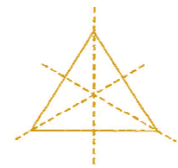
Rotational symmetry:

(ii) An isosceles triangle has only one line of symmetry and no rotational symmetry of order more than 1.
Line symmetry:

Rotational symmetry:

(iii) A quadrilateral with no line of symmetry is an irregular quadrilateral
Checking rotational symmetry
If it is rotated 90°
It does not looks same as initial figure
If it is rotated 180°

It does not looks same as initial figure
If it is rotated 360°

It looks same as initial figure
Thus,

Thus, order of rotational symmetry - 1
Hence,
A quadrilateral with a rotational symmetry of order not a line of symmetry Is not possible
(iv) A trapezium which has equal non-parallel sides, a quadrilateral with line symmetry but not a rotational symmetry of order more than 1.
Line symmetry:

Rotational symmetry:

Q.3. In a figure has two or more lines of symmetry, should it have rotational symmetry of order more than 1?
Ans: Yes, because every line through the centre forms a line of symmetry and it has rotational symmetry around the centre for every angle.
Q.4. Fill in the blanks:

Ans:

Q.5. Name the quadrilateral which has both line and rotational symmetry of order more than 1.
Ans: Square has both line and rotational symmetry of order more than 1.
Line symmetry: 
Rotational symmetry:

Q.6. After rotating by 60o about a centre, a figure looks exactly the same as its original position. At what other angles will this happen for the figure?
Ans: Other angles will be 120°, 180°,240°,300°,360°.
For 60° rotation:
It will rotate six times.
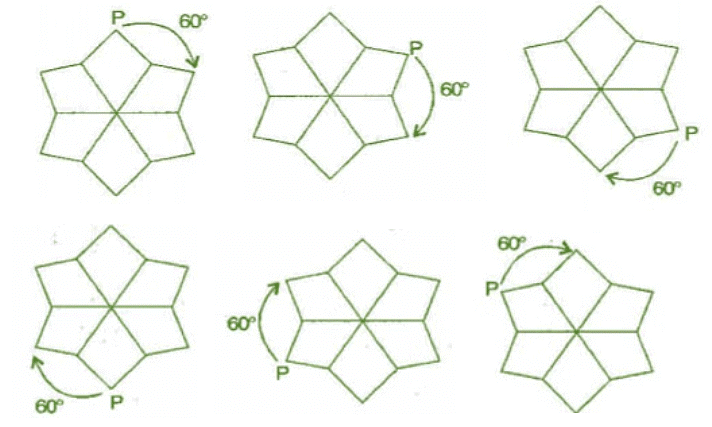
For 120° rotation:
It will rotate three times.

For 180° rotation:
It will rotate two times.

For 360° rotation:
It will rotate one time.
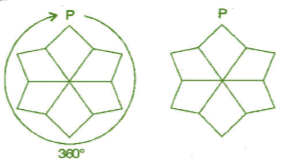
Q.7. Can we have a rotational symmetry of order more than 1 whose angle of rotation is:
(i) 45o
(ii) 17o ?
Ans:
(i) If tiie angle of rotation is 45°, then symmetry of order is possible and would be 8 rotations.
(ii) If the angle of rotational is 17°, then symmetry o f order is not possible because 360° is not complete divided by 17°.
|
77 videos|386 docs|39 tests
|
FAQs on NCERT Solutions for Class 7 Maths - Symmetry- 1
| 1. What is symmetry in mathematics? |  |
| 2. How can we identify lines of symmetry in a shape? |  |
| 3. What are the different types of symmetry? |  |
| 4. Why is symmetry important in real life? |  |
| 5. How do we solve problems related to symmetry in geometry? |  |






















